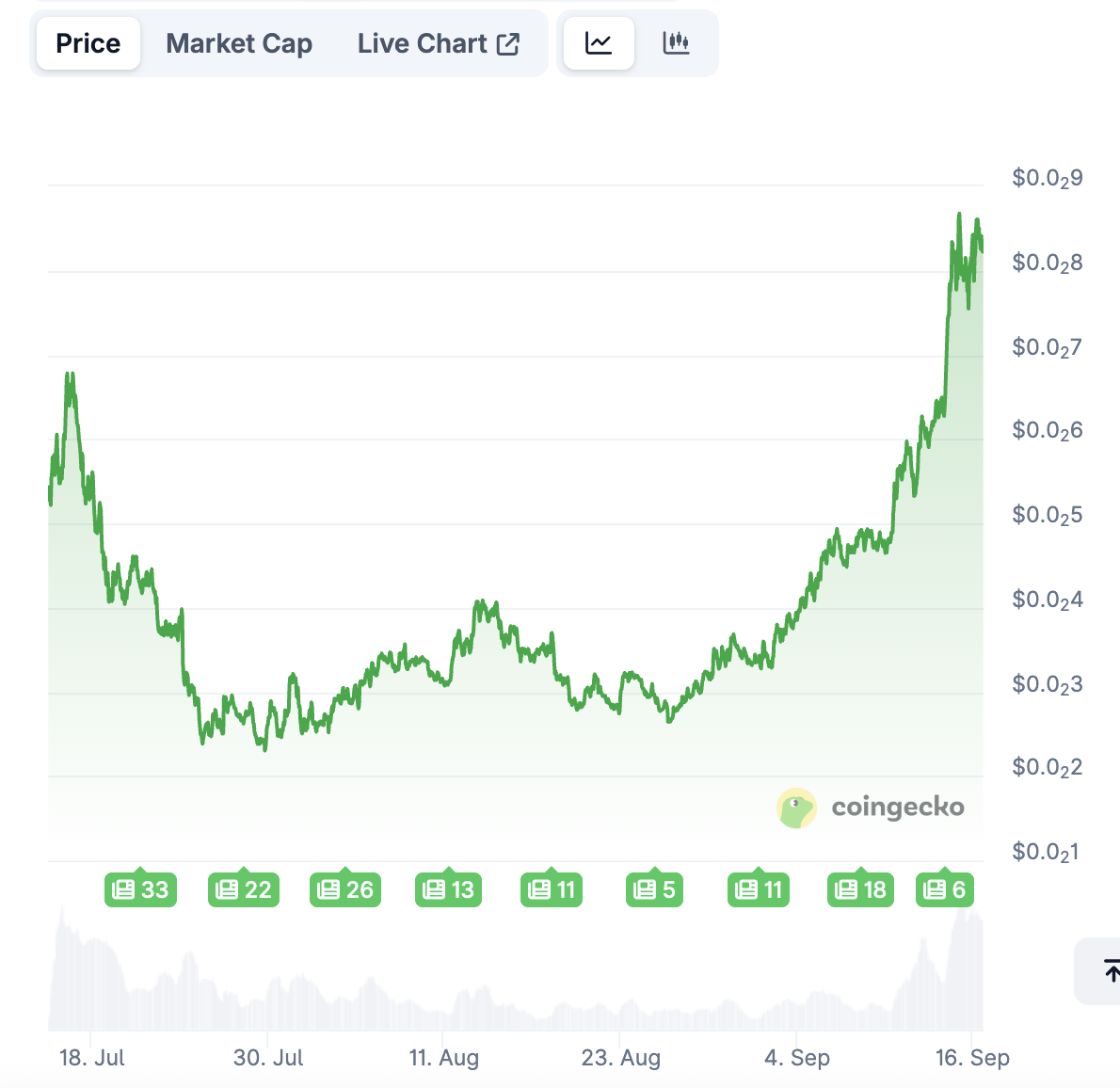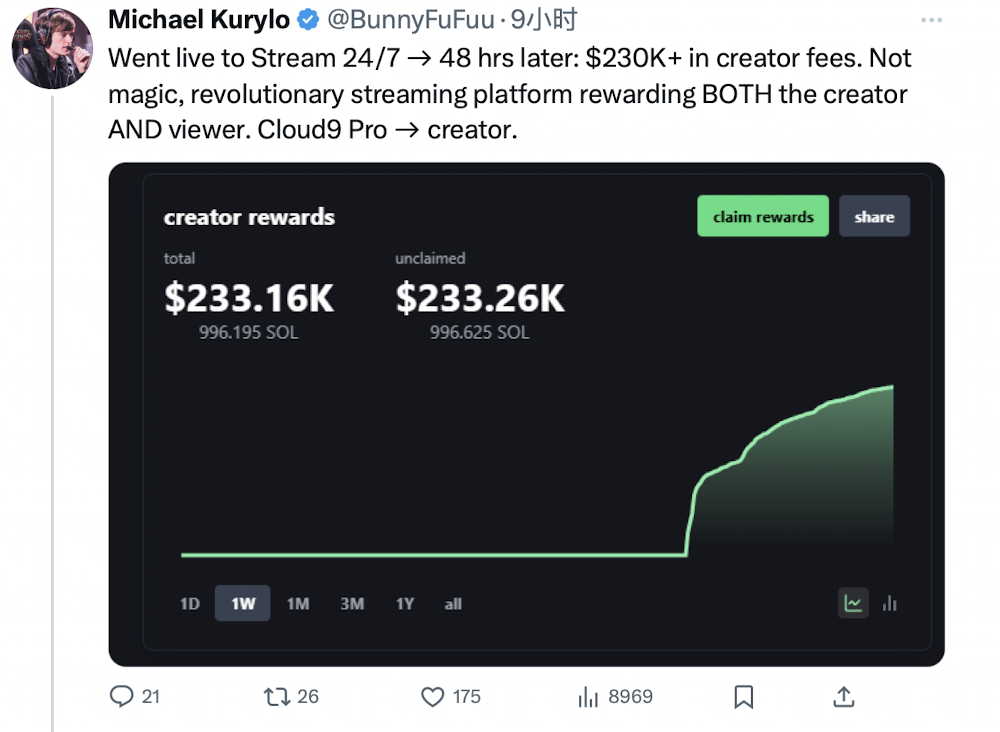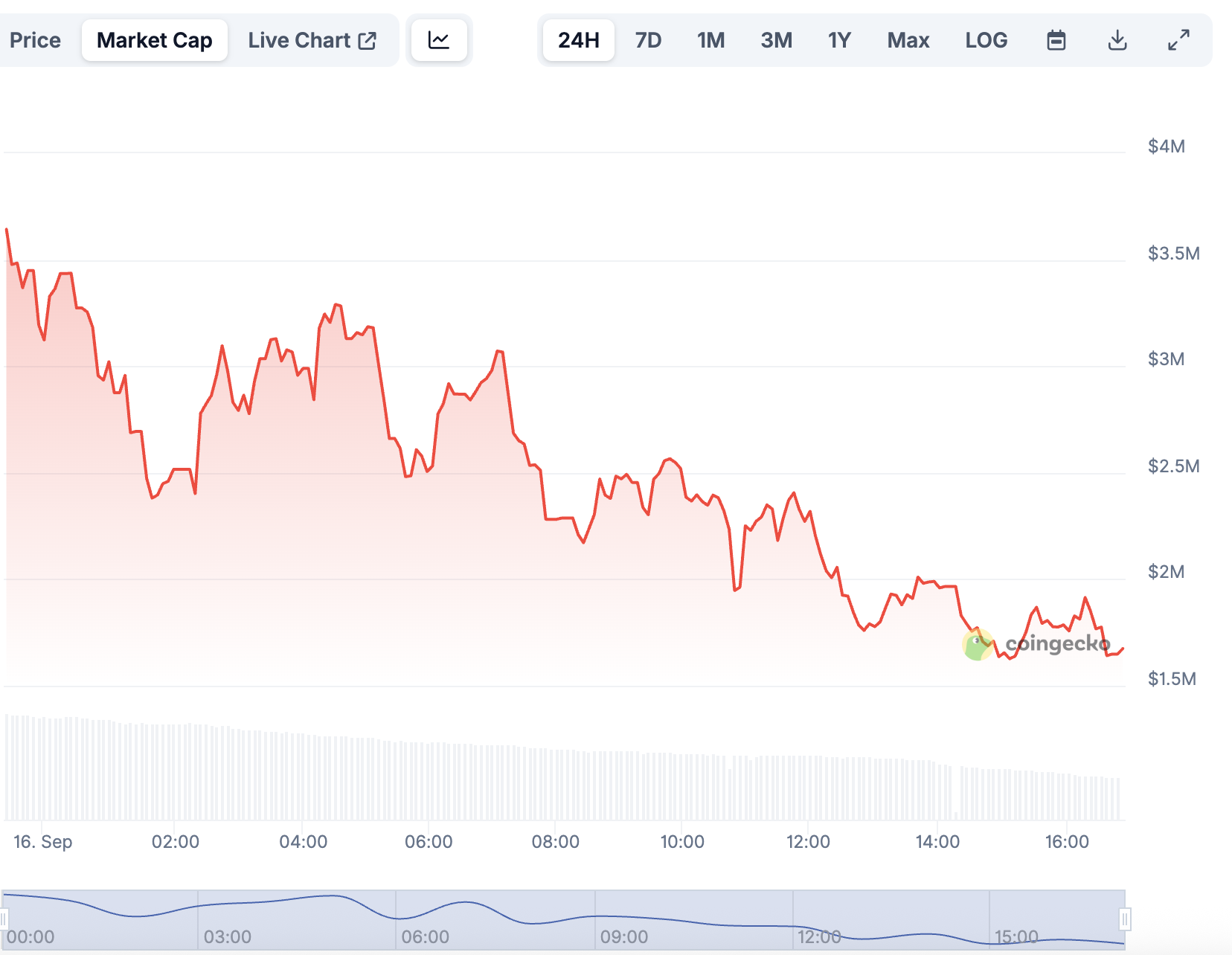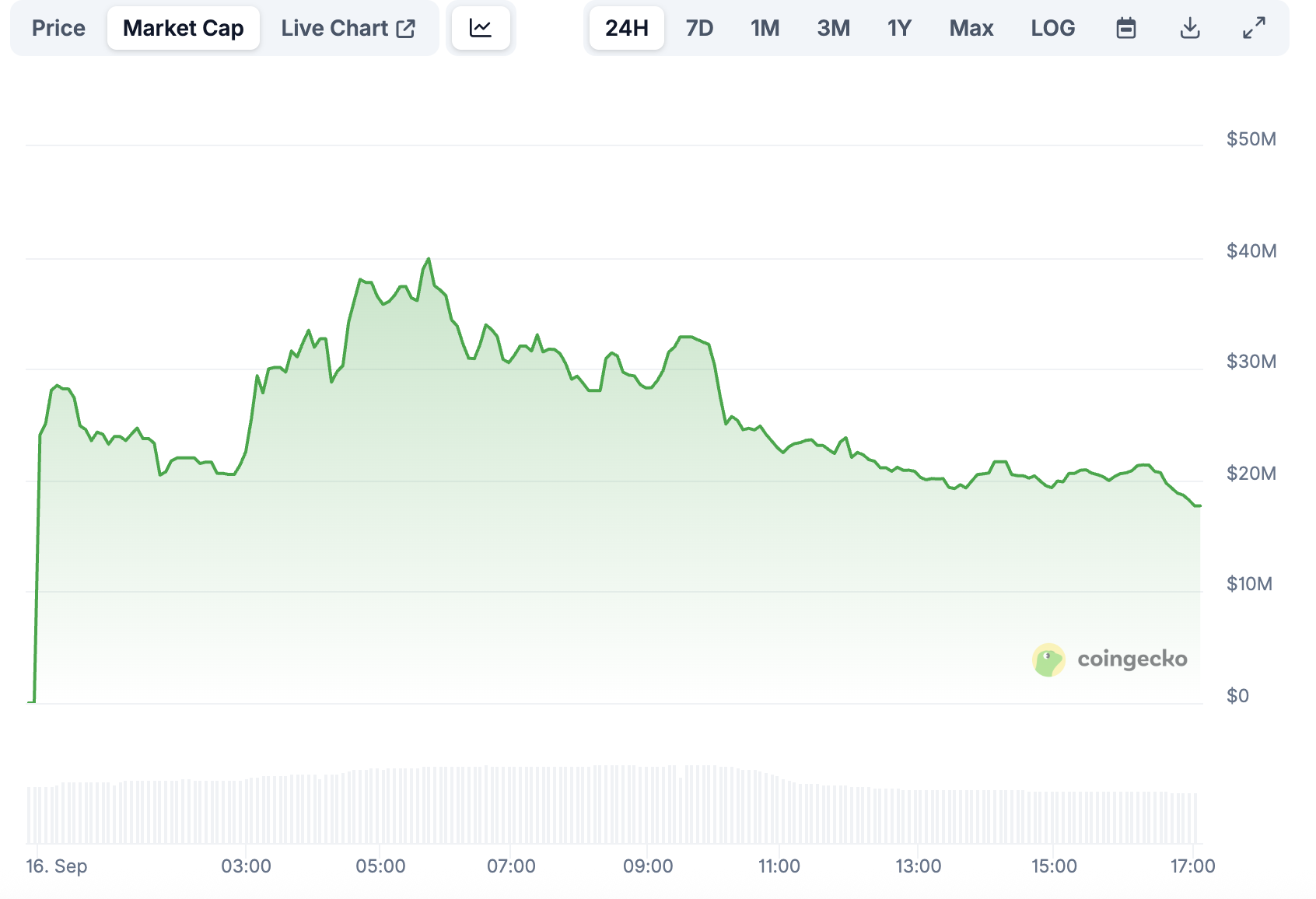When a platform's profits are built on the widespread losses of participants, this model is destined to be a fleeting speculative frenzy.
Written by: Umbrella
Recently, the live streaming feature of Pump.fun has launched, reigniting the popularity of what was once considered the largest Meme launch platform that had ended.
Along with this, the price of the $Pump token has soared, with announcements of buybacks and the launch of innovative features causing the price of $PUMP to rise rapidly from around $0.003 at the end of August to the current $0.0085, achieving a 283% increase in just half a month, with a market cap surpassing $3 billion.

On the other hand, since the launch of the live streaming feature, Pump.fun creators have been earning over $2 million daily, with weekly creator income breaking records at $15.5 million.
Many users in the market view the launch of Pump.fun's live streaming feature as a new paradigm for the CCM (creators capital market), claiming this update is a breakthrough in technological innovation in the crypto space.
On the surface, this appears to be a win-win situation, with the new feature bringing about a wealth creation myth for many retail investors, and both token prices and platform revenues rising. Fans support their favorite streamers through investments rather than gifts. However, behind all this seems to lie a more complex and unsettling reality.
Celebrity Token Cases
BUN COIN
BunnyFuFuu is a former professional esports player in League of Legends, and before engaging with Pump.Fun, he already had over 210,000 and 1.5 million followers on X and YouTube, respectively.

On September 14, BunnyFuFuu launched his own token, BUN COIN, during a live stream, and for the next two days, he continuously promoted his token on X. His efforts helped BUN COIN stand out among numerous live streaming tokens.
BUN COIN had an initial market cap of only $300,000, raising $1.5 million during the presale phase, and reached a peak market cap of $10 million within 48 hours of listing, with a maximum increase of over 3000%. However, today the price of BUN COIN has dropped to around $1.6 million, with a daily decline of over 50%.
Token CA: HQDTzNa4nQVetoG6aCbSLX9kcH7tSv2j2sTV67Etpump

KIND
The KIND token is intended to "spread goodwill," with creators promoting it through charity-themed live streams, claiming that for every $1 spent by users, $0.10 will be donated to small streamers in need of help.
Such a positive narrative has garnered widespread attention. Since its launch on September 7, KIND reached a peak market cap of $55 million early today, with a 24-hour increase of over 20 times and trading volume nearing $32 million within 24 hours. However, its current market cap has significantly corrected to $18 million.
Token CA: V5cCiSixPLAiEDX2zZquT5VuLm4prr5t35PWmjNpump

BAGWORK
In contrast to the celebrity-driven sales of BUN COIN and the positive narrative of KIND, BAGWORK's narrative is more about "stirring things up." Bagwork originates from boxing terminology, meaning to train on a punching bag. Inspired by this, BAGWORK calls on everyone to fight for their crypto assets.
At the same time, BAGWORK is currently the most influential and widely spread live streaming token within the Pump.fun platform. Undoubtedly, the BAGWORK team knows how to stir things up.
On the first day of the live stream, BAGWORK team members rushed into a sports venue to stream and were arrested during the broadcast; the next day, they stole a hat from a fitness influencer's gym and were caught and slapped; in the following days, another BAGWORK team member attempted to jump off the Santa Monica Pier but was stopped by the police. The BAGWORK team has promised to perform a new stunt every day for the next two weeks to promote the token and attract more attention.

These seemingly crazy actions have indeed driven up the price of the BAGWORK token. On September 13, the market cap of BAGWORK was only $3 million, but after 48 hours of "crazy live streaming," the token's market cap approached $100 million, currently falling back to $15 million.
Token CA: 7Pnqg1S6MYrL6AP1ZXcToTHfdBbTB77ze6Y33qBBpump
What Has the Live Streaming Feature Brought to Pump.fun?
In the traditional internet live streaming industry, streamers profit by attracting fans to reward them with gifts through gaming or talent performances, where fans giving gifts is purely a consumption behavior, not an investment behavior expecting financial returns.
In Pump.fun's live streaming, fans' rewards for streamers have transformed into token purchases, and after the streamer puts on a sufficiently exciting "show" to attract more buyers, they can cash out their profits and look for the next streamer worth investing in. In this process, fans' identities seem to shift to that of traditional MCN (multi-channel network) organizations, investing funds and resources in each streamer and profiting from the commercial value realized after the streamer becomes popular.
More critically, in this model, the best strategy for streamers to profit is often to sell tokens at opportune moments after pushing the price up, which complicates the relationship between fans and streamers. On one hand, fans want streamers to deliver more exciting performances to attract more investors; on the other hand, they want to liquidate their tokens, turning their "support" into losses.
In fact, the token trends of the three well-known cases mentioned above are already among the best performers among countless live streaming tokens. Many others quickly drop to zero as the streamers' popularity wanes or after they stop streaming. Does this script sound familiar? Indeed, the market within Pump.fun before the launch of the live streaming feature was the same. According to Solidus Labs' analysis report on 7 million Pump.fun tokens, nearly 99% of tokens ultimately go to zero, and this ratio has not improved after the launch of the live streaming feature. Successful celebrity cases remain merely statistical extremes.
So what has the live streaming feature truly brought to Pump.fun? Currently, it seems to be just a change in the medium of communication.
Divergent Market Opinions
The market controversies surrounding Pump.fun's live streaming feature also reflect some issues.
Supporters mainly focus on technological innovation and creator empowerment. They believe this model eliminates the exploitation of intermediaries by traditional platforms, allowing lesser-known yet promising new creators to access income opportunities almost equivalent to those enjoyed by top creators on Twitch from the start.
Moreover, in today's attention economy, the marketing power generated by live video far exceeds that of text media. Pump.fun itself is a product of the attention economy, and the live streaming feature is merely an iterative upgrade of previous versions.
Critics, however, pay more attention to structural flaws and content risks. Based on the trends of most tokens, these live streaming tokens almost only rise during the streamer's live broadcast and plummet rapidly after the stream ends, leading many community users to question their long-term value creation capabilities.
In terms of content regulation, although Pump.fun has restricted some inappropriate content, there are still many bloody, violent, and pornographic live streams on the platform that drive token prices by satisfying users' curiosity.
Calm Reflection Amidst Bubble Prosperity
From an investment perspective, the launch of Pump.fun's live streaming feature has indeed created many profit opportunities. As long as the streamer you follow has enough "content" and you discover such "treasure streamers" earlier than others, you can easily profit.
However, from another angle, when we strip away the glamorous exterior of Web3 innovation and creator economy, Pump.fun's live streaming model exposes a more fundamental issue: how to protect the interests of ordinary participants while incentivizing creators.
Existing data indicates that the live streaming model is unsustainable, with 99% of tokens heading to zero and over 99% of participants having incurred losses and exited, while creators and the platform secure stable profits.
It is difficult to consider such a model a healthy ecosystem; it resembles a beautifully packaged wealth redistribution game, merely masking the essence of traditional zero-sum games with narratives of technological innovation.
The real issue lies not in the innovative form of live streaming and token issuance itself, but in the fundamental flaws of the incentive mechanism. When creators' earnings are completely decoupled from the long-term interests of the community, and when the platform's profits are built on the widespread losses of participants, this model is destined to be a fleeting speculative frenzy.
We cannot know whether Pump.fun's live streaming will continue to maintain its current popularity and continuously produce "hit tokens," but we can confirm that investing in these hit live streams carries considerable risk. We hope all investors can DYOR (Do Your Own Research) and pay attention to risk control.
免责声明:本文章仅代表作者个人观点,不代表本平台的立场和观点。本文章仅供信息分享,不构成对任何人的任何投资建议。用户与作者之间的任何争议,与本平台无关。如网页中刊载的文章或图片涉及侵权,请提供相关的权利证明和身份证明发送邮件到support@aicoin.com,本平台相关工作人员将会进行核查。




